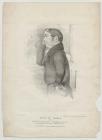Newport Rising, 1839
Items in this story:
Chartism
On 4 November 1839 the political desires of the working men of south Wales found violent expression in the Chartist Uprising at Newport. Restlessness had been rife among the working population of Britain for many months due to an eagerness to secure suffrage for working men.
The political movement of Chartism developed following the 1832 Reform Act due to the widespread disappointment at the provisions in the act. In June 1836 the London’s Workingmen’s Association was formed and in 1838, the members launched a People’s Charter and National Petition which called for radical changes to the way in which Britain was governed. Supporters of the movement were from then on known as Chartists. Among the six demands listed on the People’s Charter were frequent elections, annual parliaments, secret ballots and universal suffrage for men over twenty-one years of age.
Chartism gained popularity in Wales, particularly among the textile workers of mid-Wales and the workers of industrial south Wales, particularly Monmouthshire where Chartist lodges had been established since 1837. Tensions began to increase in 1839, with a disturbance occurring at a Chartist meeting in Llanidloes in April.
Growing Tensions
Tensions were high in the town of Newport from May onwards following the arrest of the Chartist leader, Henry Vincent, for making speeches that were deemed seditious. At the Monmouthshire Assizes in August, Vincent was sentenced to a year in prison. Anger at this sentence led to a mass public meeting arranged by local Chartist leaders to demonstrate against his imprisonment. Plans were made to march on the town of Newport.
Instrumental in the organisation of activities in the area were local leaders John Frost, Zephaniah Williams and William Jones and it was they who led the march towards Newport on the night of Sunday, 3 November 1839. Reports suggest that some seven or eight thousand men from nearby iron and coal-mining villages assembled outside Newport and began their march on the town. However, the authorities and had already arrested several Chartists, holding them in the Westgate Hotel in the town. The crowd marched on the hotel but 28 soldiers were waiting for them and began firing at the protestors. It is thought that around 50 were injured and some 22 of the Chartists were killed.
The march on Newport
Instrumental in the organisation of activities in the area were local leaders John Frost, Zephaniah Williams and William Jones and it was they who led the march towards Newport on the night of Sunday, 3 November 1839. Reports suggest that some seven or eight thousand men from nearby iron and coal-mining villages assembled outside Newport and began their march on the town. However, the authorities and had already arrested several Chartists, holding them in the Westgate Hotel in the town. The crowd marched on the hotel but 28 soldiers were waiting for them and began firing at the protestors. It is thought that around 50 were injured and some 22 of the Chartists were killed.
Arrest and Punishment
John Frost and around 60 of the most important Chartists were arrested and were sent to stand trial at Monmouthshire Assizes on 10 December 1839. In January 1840, the leaders John Frost, Zephaniah Williams and Williams Jones were found guilty of treason and sentenced to death. This sentence was later reduced to transportation for life. In 1856, following a period in Tasmania, John Frost was given a pardon and was greeted as a hero on his return to Newport.
The motives of the Newport Chartists are unclear. It seems that the intention was to spark a wider, nation-wide, rising in co-operation with similar movements across Britain. However, their actions were misguided and poorly executed and a nation-wide rising never transpired. The Chartist movement saw the refusal of two more petitions during the 1840s and had come to an end by the late 1850s.



